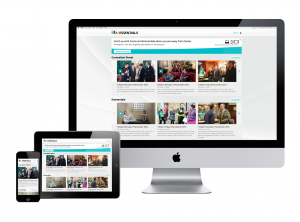Passing clouds – the evolution of OTT multiscreen delivery
Cloud-based delivery of multiscreen services is enabling service providers to experiment more freely with less risk, but broadcast and OTT delivery are likely to remain largely separate for now. Stuart Thomson reports.
 Cloud-based delivery of TV has been very much in vogue in recent months, and the reasons are not hard to find. As free-to-air broadcasters and pay TV providers attempt to deliver more services – including live TV – to multiple devices over the web, they need to be able to match unexpected peaks in demand. They also want to be able to experiment with new services without making huge upfront investments. Pure OTT providers meanwhile are seeking to scale up their services to meet demand as it grows.
Cloud-based delivery of TV has been very much in vogue in recent months, and the reasons are not hard to find. As free-to-air broadcasters and pay TV providers attempt to deliver more services – including live TV – to multiple devices over the web, they need to be able to match unexpected peaks in demand. They also want to be able to experiment with new services without making huge upfront investments. Pure OTT providers meanwhile are seeking to scale up their services to meet demand as it grows.
Multiscreen delivery in particular is costly. Fragmentation of the market for devices that can play back video, and of operating systems, with an absence of standardised ways of doing things and a lack of integration between OTT and broadcast delivery systems, have to some extent bedeviled operators as they try to optimise their delivery and drive down the costs and time taken to get services to market. So the technology choices made by OTT players, pay TV operators and broadcasters to deliver services to multiple devices plays a key role in determining whether such services will be economically viable.
Flexibility
Service providers and broadcasters are therefore increasingly turning to cloud technology to deliver their offerings with a greater degree of flexibility. Essentially, this means delivering as much as possible from software-based delivery systems hosted in data centres that can be turned up and down according to demand and do not require upfront investment. Instead, the ideal is to be able to tap into infrastructure on demand and to be able to try out – and, if they fail to attract viewers, drop – new services without taking on a huge amount of risk.
“Generally broadcasters are starting to think more strategically about broadcast and OTT,” says Dan Peters, senior vice-president, product management at Saffron Digital. In the past, he says, broadcasters and operators were typically focused on getting services up and running as quickly as possible, leading them to deploy whatever technologies were at hand. They are now attempting to think more strategically and optimise their investments. However, looking too far ahead can in its own way lead video providers to fall into some very big holes along the road. Peters cites the example-to-avoid of the BBC’s ill-fated Digital Media Intiative, a vast and all-encompassing project to update the broadcaster’s workflows and systems for the digital age that was famously abandoned subsequently, with most of the £125 million investment being written off.
“The obvious lesson is that at certain sizes projects become unwieldy. If there isn’t a quick turnaround of a few months the projects will get overtaken by events,” says Peters.
In general, broadcasters and service providers want their infrastructures to evolve to accommodate the delivery of more OTT and multiscreen services but they don’t want to have to tear out their existing systems and begin again.
“What we’ve seen is that when you’re talking to large media organisations, very often they have existing mature technology stacks that they wish to leverage to underpin new services. Ripping and replacing everything wholesale is not really viable and what we have done is create a number of point solutions that can be incorporated into an existing workflow,” says Luke Gaydon, vice-president of operations for EMEA at online video specialist Brightcove, citing the example of his company’s Zencoder multiscreen encoder, which supports standards such as MPEG Transport Stream, HbbTV and MPEG-DASH.
Brightcove has supplied a range of products that are designed to plug into broadcasters’ and other service providers’ existing systems. In addition to its overarching Video Cloud infrastructure, the company is launching a new media player that can be provided separately. “It doesn’t need to connect to Video Cloud. If you have a media asset management system or content management system, but are looking to add a fast player, you could leverage it,” says Gaydon.
The player is designed, he says, to be a single player that can relatively easily work across multiple types of device. He contrasts this with the practice – driven by necessity – of developing different players for specific platforms. “There is a huge overhead in maintaining these different players,” he says.
The need to develop different players for different devices and operating systems has been driven in some cases by the need to replace content and adverts at a local level. “To remove that [requirement], you should look at providing ad and content replacement on the server side,” says Gaydon. Brightcove has developed a product called Once to enable server-side advert and content insertion, enabling service providers to use the native player on each device rather than developing their own.
Video processing
The cost of video processing – encoding and transcoding to prepare content for multiple devices and delivery routes – can increase dramatically as services grow, particularly given the different formats that operators need to support to deliver to an ever-growing range of iOS, Android, Windows-based and other devices. This has led to a growing reliance on software-based processing in the OTT world – something that can be contrasted with the dedicated hardware encoding platforms generally preferred by traditional broadcasters.
Video processing specialist Elemental introduced its cloud platform one year ago. According to Keith Wymbs, vice-president of marketing, recent developments across the industry have included a growing emphasis on the need to introduce live streams to accompany on-demand and catch-up content. Elemental introduced file-based processing in the first phase of its cloud rollout and has followed up with support for live encoding. Wymbs says service providers typically deliver coverage of live events rather than retransmitting 24-hour linear channels wholesale.[icitspot id=”224331″ template=”box-story”]
Concerts and big sports events often mean big spikes in demand for web video – a clear case where cloud-based processing can come into its own by allowing providers to meet additional demand without the need to invest in their own dedicated equipment.
Wymbs says that Elemental’s system for live workflow can enable operators to provide multiple streams (for example with different camera positions at sports events), delivering mezzanine format-based feeds to the cloud for processing for delivery to HLS and Smooth Streaming-based platforms.
“A live encoder is more complex in that you need to maintain timing in encoding. The same is true in live workflow. You can’t get ahead or behind or you break the live nature of the streams. Since those are being maintained in the cloud it is a bigger challenge to qualify that workflow and test it out to get the bit-rate right for contribution,” says Wymbs.
There is essentially a trade-off between reliability and quality, with bit-rates kept relatively low for the former but pushed higher to deliver high-quality, high-resolution streams.
Andy Salo, vice-president of product management at RGB Networks, agrees that there has been a sharp increase in interest in cloud-based service delivery in recent months. RGB Networks provides CloudXtream, a service delivery platform that has been used to deliver cloud-based DVR and ad insertion.
“There is no lack of standards but at the same time there is no standard way of doing things,” says Salo. Operators have to deal not only with a range of formats, but with formats that are constantly evolving and require adaptation. They face high per-user costs to acquire and format content that make a mockery of any business case.
Salo highlights two open source technologies that have been widely adopted in order to bring some order to proceedings – OpenStack and Docker. The former enables operators to deploy ‘virtual servers’ in data centres in a semi-standardised way using open source technology. OpenStack, backed by a number of large companies, is designed to give operators a single way of managing their applications across different data centres.
Docker, says Salo, essentially does the same at the app level, providing a ‘virtual container’ for apps that can sit either on a virtual machine or an actual hardware server. Essentially, by providing a ‘container’ for apps that is smaller and more flexible than a virtual machine, Docker liberates app-based service providers from some of the constraints and costs they previously faced. Google has committed to deploy Docker 1.0 in its Google Cloud platform. According to Salo, Docker is positioned to become “the new virtual machine” and services will likely be based on OpenStack plus Docker to maximise flexibility. “This will be yet another reason for people to see the light and deploy cloud-based apps,” he says.
More innovative
Salo proselytises the merits of OTT as the future of video. Initially, he says, RGB’s customers want unified management of OTT and broadcast, “but essentially everything is going to be OTT ultimately”. He compares the trajectory of video services with that of voice, where the idea of having a separate dedicated voice platform is now hopelessly outmoded.
OTT and multiscreen video is increasingly as good as – or, in the view of some of technology providers, better than – traditional broadcast systems. While standard features of broadcast services such as closed captions have been available in equivalent OTT services for some time, adding such features as captions, teletext and multiple language support in multiscreen deployments can be challenging. “The traditional providers have spent many years complying with DVB and MPEG standards but on the multiscreen side we are seeing more fragmented systems because each protocol is a bit different,” says Wymbs.
For Mark Christie, chief technology officer at online video specialist Piksel, “consistency in terms of brand” across devices is less important in most cases than delivering the best service that a particular device can support.
“OTT is not trying to look more like the broadcast way of doing things. People got used to the grid-type EPG and the remote [but] now you have touch screen devices and so on that allow you to be more innovative around the experience,” he says. If multiple OTT providers are essentially providing the same mix of content, they will really only be able to differentiate based on the user experience they provide, meaning that it makes sense to configure a service to show each device at its best. “The distinction is down to the experience if content is the same between services.”
Envivio, another pioneer of software-based encoding, has captured significant business from the drive amongst service providers to deliver video over-the-top to multiscreen devices. Recent developments for the company include the launch of services for Sky Go and Envivio teaming up with cloud-based billing and middleware provider 1 Mainstream to deliver video services for operators. The company, which has previously delivered services to operators using the VMware infrastructure, also announced its integration with OpenStack at the NAB Show. The Software-Defined Network (SDN), also supported by Envivio, is another attempt to introduce some sort of standardised way of doing things – in this case focusing on quality assurance and bandwidth, relating capacity requirements to the requirements of each specific app.
Boris Felts, the company’s vice-president of product marketing says that operators are “looking to virtualise and move into software” via the ‘software-defined network’ as well as pushing for standardisation of the data centre infrastructure and a common infrastructure for public and private cloud-based delivery.
“Anything that requires investing in hardware is complex. Once you move into a virtual network some of the pain points go away. The main reason a Comcast or AT&T is looking at this is to gain flexibility and become more agile in launching applications,” says Felts.
While initiatives including OpenStack, the SDN and Docker are clearly well-intentioned, Felts admits that “all these new initiatives are not fully mature” and that people typically still use commercial, proprietary technologies that perform the same functions, such as VMware, a commercial off-the-shelf product that provides much the same functions as OpenStack.
Software processing
Nevertheless, he says, operators are using those technologies that are practical to use in order to gain flexibility. Flexibility – meaning an ability to turn services on and off and to scale them up and down to meet spikes and dips in demand – is the goal that really unifies operators. “People are launching services in a much more agile way than they used to do,” says Felts. “They are seeing the benefits of using software and off-the-shelf servers and virtualisation.”
Change is being driven by the new, agile OTT players. More traditional pay TV operators realise they can no longer plan changes to their services over a five-year period – they have to be in a position to respond quickly to the needs of a fast-changing market.
Felts also says that multiscreen services are becoming more like full-service offerings, combining a full range of live channels with on-demand and catch-up content. He says people are also increasingly demanding broadcast-quality bit-rates – or better – from OTT particularly as web-delivered video moves towards the big screen. HEVC, enabling a 30-50% saving in bandwidth, can be used to deliver 1080p60 video over the web.
The rise of OTT and multiscreen video has given a major fillip to software-based video processing and delivery systems and their providers. While traditional broadcast delivery chains have relied in the past on dedicated hardware platforms, on the OTT side the flexibility and cost-effectiveness of software has swept all before it.
Elemental’s Wymbs says that content preparation for OTT and multiscreen distribution is increasingly based on software, even if contribution remains an area where hardware-based technologies are likely to maintain their market share for some time to come. The shift to software was evident at the NAB Show earlier this year when Harmonic announced a major shift to a software-focused approach with its unveiling of VOS, designed to enable virtualised video processing from a single software platform, encompassing functions that have hitherto been managed discretely such as ingest, playout, graphics, branding, compression, packaging and delivery. Ericsson also announced at the show that it had integrated its EVE management layer with Elemental’s encoding platform.
“There are large entities looking at software for 24/7 operations as part of their virtualisation strategy because they can’t have that [hardware] asset sitting stranded,” says Wymbs. He says that in the OTT and multiscreen domain operators have to be able to experiment with new services and applications – and ultimately to see them fail – without having to invest huge sums of money upfront in infrastructure. The pace of change in software processing power also means that any video service provider would be advised to maintain maximum flexibility.
HEVC and convergence
“These days I don’t sense that buyers are able to determine whether an investment will look smart in three months,” says Wymbs, adding that cloud-enabled delivery allows operators to change their platforms in a shorter timeframe. “Even if you don’t take every single software release you can do easily change the platform every six months.”
For broadcasters and service providers used to a slower pace of development, the world of OTT can be challenging – particularly if they wish to integrate their broadcast and new media operations.
While OTT and multiscreen delivery is dominated by software technology, for pay TV and other traditional broadcasters, OTT-based delivery is still for the most part treated separately from the main business of broadcast. But with multiscreen services now received by growing numbers of homes, some broadcasters and service providers may ultimately look to migrate their ‘traditional’ broadcast systems to a more OTT-like technology platform.
The complexity of integrating very different infrastructures means that this will likely progress in piecemeal fashion. Piksel’s Christie says that “it makes sense to ingest content once and have workflows in place for the broadcast headend and the OTT side as well”. OTT, he says, is having an impact on the way media companies are organised, by demonstrating the importance of metadata and feature-rich content management systems. These systems, he says can also benefit the broadcast side of the business.
According to Felts, a growing number of operators are trying to converge their broadcast and broadband platforms. He cites the example of a customer of Envivio’s in Portugal. The fact that off-the-shelf hardware is becoming increasingly dense means that the main objection to delivering video from a data centre – that the latter takes up more space and is less efficient in terms of power consumption – rather than a broadcast centre is fading away. In any case, the opportunity to pool resources in a data centre means that the space and power demands of any single virtual headend are largely irrelevant. For operators seeking to deploy HEVC-compressed video services, there is in any case little choice as no HEVC compression chipset currently exists.
Elemental’s Wymbs also says that some operators are already making the shift. While Elemental has not been traditionally known as an MPEG-2 compression supplier, the company is providing this for Comcast’s Xfinity platform in the US, he points out. He also says that live video is increasingly being seen as a key part of multiscreen.
While migration away from traditional hardware systems for broadcast may be some time off, Wymbs believes that the introduction of HEVC as the compression system for the next generation of headend and consumer premises gear may push things towards a tipping point in favour of software-based processing.
Up to now, much work on new HEVC/H.265 compression has been focused on how to deliver 4K services efficiently, with its use for OTT video happening more slowly – the reverse of what many people believed would be the case when HEVC first emerged. Currently, most devices decode HEVC video in software. “When a new device with native support for HEVC comes out that will be a big milestone for the industry,” says Wymbs, adding that Elemental currently makes about 10% of its revenues from HEVC – though with the bulk of this related to 4K rather than OTT.
Envivio’s Felts believes that HEVC is on the way up and will be adopted for a wider range of applications, pointing out that the latest generation of smart TVs support the format, while tablets can already decode HEVC in software and devices with hardware-based decoders also on the way. “Operators will try to differentiate based on video quality,” he says. “Higher resolution services will be a true differentiator.”
For Piksel’s Christie, much depends on how organisations are structured and how willing and able teams are to work together towards a common end. “There are lots of organisations that still treat OTT as part of ‘new media’ with different reporting structures [to broadcast], so it is also about how the organisation comes together. It depends on how forward thinking organisations are,” he says.
Brightcove’s Gaydon sees room for optimism on that score, with broadcasters looking to integrate the broadcast and digital teams. Playout providers such as Red Bee Media and others are also typically now delivering specific digital capabilities. “There has been a collapsing of the distinctions between these activities,” says Gaydon.
Cloud-based delivery has the potential to transform the economics of OTT and multiscreen delivery but operators’ Christmases are unlikely to come at once. Service providers are not taking things as far as entirely virtualising their video delivery infrastructure by contracting the process out wholesale to a third-party data centre. Similarly, the convergence of broadcast and OTT is certainly not something that will happen immediately, but there has been a considerable amount of discussion around whether all or some of broadcast channel line-ups could more efficiently be delivered via OTT, with claims and counter-claims being made about the likelihood of bandwidth costs falling to an extent that investing in expensive broadcast infrastructure no longer makes sense. What is clear is that a growing number of services are being delivered over hybrid platforms, with additional channels available on internet-connected broadcast platforms via the red button or a hybrid EPG.
Sooner or later, growing use of the cloud will help transform not only OTT but all TV. In the meantime, pay TV operators and broadcasters will continue to find their way to deliver services over a hybrid infrastructure as efficiently as possible.



